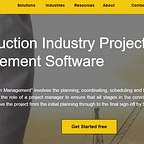Construction Risk Assessment
Construction projects can be dangerous places so understanding risk assessments and safety management is vital. Everyone from the project manager to the site foreman need to be aware of any and all risks at every stage in the construction process. So, controlling risks takes good risk management to prevent or minimize the realization of any risks.
A construction risk assessment should be first addressed at the design stage to address any potential risks before the project ever begins. Next up, the project managers should complete a project risk assessment before any worker sets foot on the site and also have a method to monitor any risks at each stage of construction, a tool that can consider all the risks and possible risks. The tool or system should also be able to help the project manager mitigate any perceived risks and the financial cost associated with each risk. Also, it is important to be able to consider the cost to the whole project if they were to occur.
This brings us to the question; how do you stay on top of managing project risk assessments? The answer is you need good processes, procedures and construction management software. Here are some steps to help keep construction risks under control.
Know the source of potential risks
To manage construction risks, complete a construction risk assessment. Be thorough and consider the following areas:
- Contractual risks. Missing milestone deadlines can cost time, money and a business its reputation.
- Occupational risks. The nature of a construction site means there are many risks that can cause injury and possible death. Worker behaviour, technology, working methods, weather or a third party can cause accidents.
- Project risks. The lack of good project management, workplace procedures, or workplace policies and procedures that are ignored and poor time management are just few project risks.
- Natural risks. Natural risks (storms, earthquakes) are beyond your control but can shut a construction site down.
- Financial risks. Financial risks include rising interest rates, a surge in material prices and a lack of sales.
- Stakeholder risks. Use project management software to bridge communication problems, miscommunication over changes and deliverables.
- Competition. Competitors can make life tough. They can drop prices to undercut prices and build times. This can put you under pressure to meet the same terms and put the project’s profit at risk.
Assess risks for their order of importance
Assess the risks into order of importance from most likely to occur to the least likely. Also, rate each risk for the level of damage it can do if it does occur and the potential cost to your business.
Dealing with identified risks
Construction sites are busy, dangerous places. Although the risks are varied, there are four basic management techniques to manage risks:
- Avoid. You may choose to only take on a project in the summer of an area that has winter snow to avoid the risk of time delays.
- Transfer. Ensure there are good contracts in place with suppliers and subcontractors so they take responsibility for missing deadline agreements with the company. Make sure the project has the appropriate insurances to cover any accidents.
- Mitigate. Some risks you cannot completely remove. You can reduce the dangers of safety hazards, for example, but you cannot completely remove them.
- Accept. Seasonal weather can be difficult to avoid. But, with planning and long-range forecasts you can work to reduce the impact on the project.
Use the right software
Once you decide how to deal with the risks arising from a project risk assessment, use technology to help optimize risk management methods. Good construction project management software helps manage all facets of a construction project. From costs to risk management, good software can make all facets of construction management more manageable and save time by:
- simplifying the project risk assessment process
- helping businesses comply with legislation
- assessing and recording all tasks and risks on a risk assessment matrix
- opening up transparent communication between managers, workers and stakeholders
- adding everyone involved in the project along with their contact details into a central database
- producing project-specific risk assessment and method statements
- customizing the software to meet the needs of individual projects
- providing a safe repository for project related documents that is available 24/7.
Get everyone involved in risk management
Construction risk assessment and management is everyone’s problem. Good project managers get everyone on the construction site involved in risk assessments and managing the risks.
Consult workers when completing project risk assessments. They are the ones at risk on construction sites. It is good to get their perspective and input on construction risks in their area. This gives workers ownership of the risks and more likely to comply with workplace procedures. Always communicate any changes and updates to keep everyone working with the same understanding.
